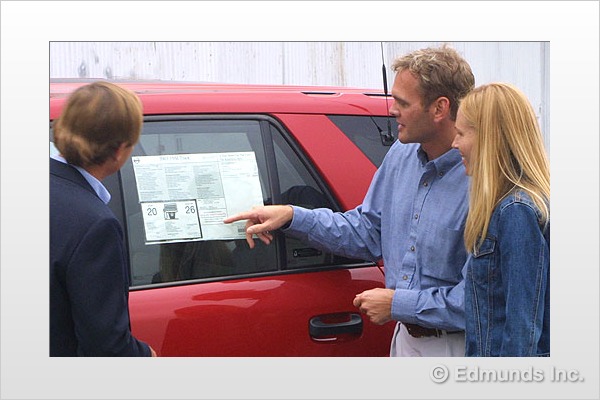
As the 2008 model-year cars hit the lot, shoppers will notice a big difference — the EPA has changed its fuel economy testing methods to produce mileage estimates that reflect "real world" driving habits. The new testing process will significantly reduce estimated fuel economy — in some cases up to 25 percent.
The new EPA estimates for city and highway mileage will be listed on the window sticker of all 2008 model-year vehicles. The first day that 2008 models hit showrooms is January 2, 2007.
The previous EPA estimates were often criticized for being overly optimistic because they were based on the driving habits of the 1970s. The system was revised once, in 1985, but hasn't been adjusted since the 55 mph national speed limit was ended in 1987.
The new EPA fuel economy regulations consist of the following three elements:
Here is a closer look at the changes to the EPA fuel economy regulations.
Revised testing procedures
The EPA has determined that changes to the testing procedure will produce fuel economy estimates that more accurately match what consumers will actually experience. The agency has also determined that important factors are missing from the current tests. Consequently, the new tests will include:
Drivers will quickly notice a big difference between the fuel economy estimates using the testing methods prior to 2008 and the new testing methods.
New fuel economy labeling system
The window sticker for 2008 and newer models will include the following changes:
SUV and vans (8,500 to 10,000 pounds GVWR) now included
For the first time, SUVs and vans between 8,500 and 10,000 pounds GVWR will have mileage estimates. Previously, all vehicles over 8,500 pounds GVWR were exempted from fuel economy testing and labeling requirements.
Fuel economy test history
In the 1960s, emissions testing programs began using a city loop in the Los Angeles basin. The 11-mile test was later standardized to run on an indoor dynamometer, a machine for measuring horsepower, torque and other engine dynamics. The so-called Federal Test Procedure (FTP) was adopted by the EPA for the fuel economy ratings program that began in the '70s.
The FTP 11-mile loop, with an average speed of 21 mph and top speed of 56, was used to provide the first "city" mpg ratings. In 1974, a Highway Fuel Economy Test (HFET) was developed to measure highway fuel economy. This 10-mile loop was also performed indoors on a dynamometer with an average speed of 49 mph and top speed of 60 mph, in recognition of the fact that people often exceeded the current 55 mph national speed limit.
Together, the FTP and HFET formed the basis for the initial fuel economy labeling program.
In the early 1980s pressure began to build for a revamp of the system, because the ratings were found to be outdated. The complaints were that test speeds were too low, the dynamometer test doesn't account for temperature and no air conditioner data was collected.
In 1984, a new rule applicable to 1985 and later vehicles was adopted. No changes were made to the FTP and HFET tests themselves, as doing that would cause problems for the entrenched emissions testing protocol. Instead, the fuel economy ratings were given a "downward adjustment." FTP city results were reduced by 10 percent to determine the new city rating. The new highway ratings were determined by a 22-percent reduction in HFET results.
Those changes worked well at the time, when speed limits were still 55 mph. But this system is still in place until the end of the 2007 model year.
Mounting complaints about the adjusted fuel economy figures system cited a number of problems:
Hybrid fuel economy will drop
In general, in order to get the highest window sticker possible, ultrahigh fuel economy vehicles like hybrids have, more than any other class of vehicle, been developed and tuned around the idea of doing well on the FTP and HFET test cycles. Reports from consumers that hybrids don't get anything close to the label values are an illustration of how unrealistic the outgoing tests have been, and illustrate the need for a realistic test method since manufacturers will "teach to the test" as much as they can.
Why will the new testing system affect hybrid vehicles so severely? There are several reasons:
What this means for car shoppers
Fuel economy labeling is good for comparative shopping, one of the goals for the EPA testing program. However, it is less valuable if the estimates do not accurately reflect the mileage folks are actually getting in their own vehicles.
It is important for shoppers to understand that new testing methods are in use in the 2008 model year. If not, consumers could find themselves comparing 2007 and 2008 vehicles without realizing that the fuel economy figures are very different.
If both 2008 and a 2007 model-year cars are on your shopping list keep in mind that the fuel economy ratings can't be directly compared. The 2008 car will appear to get lower city and highway mileages. The city mileage will be about 12 percent lower than the 2007 estimate while the highway mileage will be approximately 8 percent lower than the 2007 estimate.
For more information and resources check this Web site.
It is also important for shoppers to realize that even the 2008 mile estimates are only that — estimates of what they will actually get. Many factors will determine the actual mileage they will get.